Melem-Ana of Unug (? - c. 2546 BC) was the 11th lugal of the First Dynasty of Uruk. He ruled in Mesopotamia in modern-day Iraq. Little is known about Melem-ana.
The Sumerian King List places him after Mesh-he and he would have ruled for 6 years. [1] It is believed he died after the year 2552 BC. Whether Lugal-kitun succeeded him, however, is not completely established.

The Sumerian King List or Chronicle of the One Monarchy is an ancient literary composition written in Sumerian that was likely created and redacted to legitimize the claims to power of various city-states and kingdoms in southern Mesopotamia during the late third and early second millennium BC. It does so by repetitively listing Sumerian cities, the kings that ruled there, and the lengths of their reigns. Especially in the early part of the list, these reigns often span thousands of years. In the oldest known version, dated to the Ur III period but probably based on Akkadian source material, the SKL reflected a more linear transition of power from Kish, the first city to receive kingship, to Akkad. In later versions from the Old Babylonian period, the list consisted of a large number of cities between which kingship was transferred, reflecting a more cyclical view of how kingship came to a city, only to be inevitably replaced by the next. In its best-known and best-preserved version, as recorded on the Weld-Blundell Prism, the SKL begins with a number of antediluvian kings, who ruled before a flood swept over the land, after which kingship went to Kish. It ends with a dynasty from Isin, which is well-known from other contemporary sources.
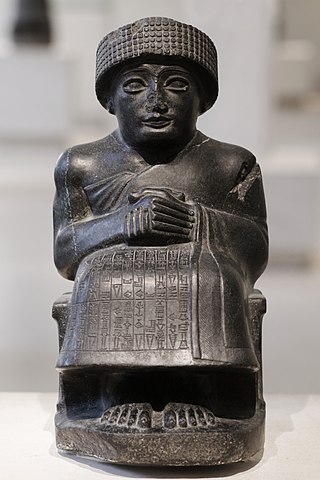
The history of Sumer spans the 5th to 3rd millennia BCE in southern Mesopotamia, and is taken to include the prehistoric Ubaid and Uruk periods. Sumer was the region's earliest known civilization and ended with the downfall of the Third Dynasty of Ur around 2004 BCE. It was followed by a transitional period of Amorite states before the rise of Babylonia in the 18th century BCE.

Mesannepada, Mesh-Ane-pada or Mes-Anne-pada was the first king listed for the First Dynasty of Ur on the Sumerian king list. He is listed to have ruled for 80 years, having overthrown Lugal-kitun of Uruk: "Then Unug (Uruk) was defeated and the kingship was taken to Urim (Ur)". In one of his seals, found in the Royal Cemetery at Ur, he is also described as king of Kish.
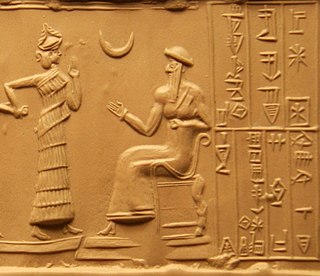
Ur-Nammu founded the Sumerian Third Dynasty of Ur, in southern Mesopotamia, following several centuries of Akkadian and Gutian rule. His main achievement was state-building, and Ur-Nammu is chiefly remembered today for his legal code, the Code of Ur-Nammu, the oldest known surviving example in the world. He held the titles of "King of Ur, and King of Sumer and Akkad".

The Gutian dynasty was a line of kings, originating among the Gutian people. Originally thought to be a horde that swept in and brought down Akkadian and Sumerian rule in Mesopotamia, the Gutians are now known to have been in the area for at least a century by then. By the end of the Akkadian period, the Sumerian city of Adab was occupied by the Gutians, who made it their capital. The Gutian Dynasty came to power in Mesopotamia near the end of the 3rd Millennium BC, after the decline and fall of the Akkadian Empire. How long Gutian kings held rulership over Mesopotamia is uncertain, with estimates ranging from a few years up to a century. The end of the Gutian dynasty is marked by the accession of Uruk ruler Utu-hengal, marking the short lived "Fifth dynasty of Uruk", followed by Ur ruler Ur-Nammu, founder of the Third Dynasty of Ur.

Lugal-Zage-Si of Umma was the last Sumerian king before the conquest of Sumer by Sargon of Akkad and the rise of the Akkadian Empire, and was considered as the only king of the third dynasty of Uruk, according to the Sumerian King List. Initially, as king of Umma, he led the final victory of Umma in the generation-long conflict with the city-state Lagash for the fertile plain of Gu-Edin. Following up on this success, he then united Sumer briefly as a single kingdom.

Lugal-Anne-Mundu was the most important king of the city-state of Adab in Sumer. The Sumerian king list claims he reigned for 90 years, following the defeat of Mesh-ki-ang-Nanna II, son of Nanni, of Ur. There are few authentic contemporary inscriptions for Lugal-Anne-Mundu's reign; he is known mainly from a much later text, purporting to be copied from one of his inscriptions.
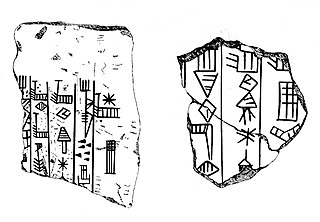
Enshakushanna, or Enshagsagana, En-shag-kush-ana, Enukduanna, En-Shakansha-Ana, En-šakušuana was a king of Uruk around the mid-3rd millennium BC who is named on the Sumerian King List, which states his reign to have been 60 years. He conquered Hamazi, Akkad, Kish, and Nippur, claiming hegemony over all of Sumer.

Mesilim, also spelled Mesalim, was lugal (king) of the Sumerian city-state of Kish.
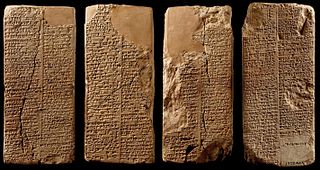
Ubara-tutu of Shuruppak was the last antediluvian king of Sumer, according to some versions of the Sumerian King List. He was said to have reigned for 18,600 years. He was the son of En-men-dur-ana, a Sumerian mythological figure often compared to Enoch, as he entered heaven without dying. Ubara-Tutu was the king of Sumer until a flood swept over his land.

En-sipad-zid-ana appears as the second king of Larak in some versions of the Sumerian King List (SKL). According to that literary composition, En-sipad-zid-ana ruled for 28,800 years. The kings on the early part of the SKL are usually not considered historical, except when they are mentioned in Early Dynastic documents. En-sipad-zid-ana is not one of them.
Barsal-nuna of Kish was the seventeenth Sumerian king in the First Dynasty of Kish, according to the Sumerian King List. His father was En-me-nuna; he succeeded his brother Melem-Kish. His name may have meant Sheep of the Prince. Barsal means A sheep. Barsal-nuna is not mentioned in Early Dynastic documents, meaning that is likely that he was not a historical person.
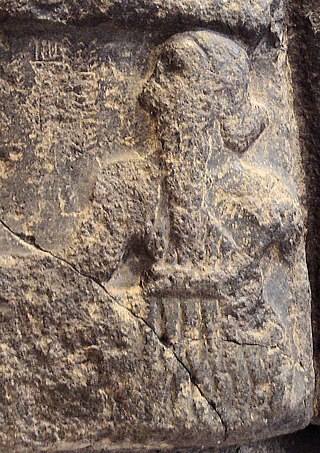
Sargon of Akkad, also known as Sargon the Great, was the first ruler of the Akkadian Empire, known for his conquests of the Sumerian city-states in the 24th to 23rd centuries BC. He is sometimes identified as the first person in recorded history to rule over an empire.
Iddin-Dagan, fl.c. 1910 BC — c. 1890 BC by the short chronology or c. 1975 BC — c. 1954 BC by the middle chronology) was the 3rd king of the dynasty of Isin. Iddin-Dagan was preceded by his father Shu-Ilishu. Išme-Dagān then succeeded Iddin-Dagan. Iddin-Dagan reigned for 21 years He is best known for his participation in the sacred marriage rite and the sexually-explicit hymn that described it.
Mesh-He is the 10th lugal of the first dynasty of Uruk. He ruled in modern-day Mesopotamia. Little is known about Mesh-he.
Lugal-kitun was the 12th and last lugal of the first Dynasty of Uruk. He ruled in Mesopotamia in modern-day Iraq. Little is known about Lugal-kitun.

Il was king of the Sumerian city-state of Umma, circa 2400 BCE. His father was Eandamu, and his grandfather was King Enakalle, who had been vanquished by Eannatum of Lagash. Il was successor to Ur-Lumma. According to an inscription, before becoming king, he had been temple administrator in Zabalam: "At this time, Il, who was the temple administrator of Zabalam, marched in retreat from Girsu to Umma and took the governorship of Umma for himself." He ruled for at least 14 years.

En-hegal, also Enhengal, was possibly an ancient ruler of the Sumerian city-state of Lagash. Only one inscription mentioning him is known, the "Tablet of En-hegal", describing a business transaction. If indeed a king of Lagash, it is estimated he would have ruled circa 2570 BCE.

Lugal-kinishe-dudu also Lugal-kiginne-dudu , was a King and (ensi) of Uruk and Ur who lived towards the end of the 25th century BCE. The Sumerian King List mentions Lugal-kinishe-dudu as the second king of the dynasty after En-shakansha-ana, attributing to him a fanciful reign of 120 years.

Lugal-kisalsi, also Lugaltarsi was a King of Uruk and Ur who lived towards the end of the 25th century BCE, succeeding his father Lugal-kinishe-dudu, according to contemporary inscriptions, although he does not appear in the Sumerian King List. In one of his inscriptions, he appears as "Lugalkisalsi, the first-born son of Lugalkigenedudu, king of Uruk and Ur".